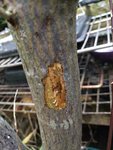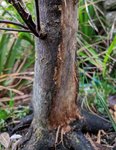Guffmeister
Seedling
Hi all,
I've got a Japanese maple which I've been growing from a small sapling over the last 10 years or so, and which suddenly died back quite drastically over the course of the summer. I had attributed this die back initially to the fact that I moved it into a nice protected corner of the garden, only for my neighbour's fence to blow down and create a wind tunnel effect. The whole canopy died back, but because I've been pruning it back systematically for the last two years to reduce its size and feeding it well, there were lots of small buds near the base that burst out in response - the only branches that survived were the ones below the wall beneath where the fence should be, which confirmed my suspicions that this die back was because of the wind. I was quite content that this was the reason, and because I had been trying to get the tree to back bud over the last few years this die back was oddly not too devastating since the plant has sent up new shoots from nearer the base of the trunk that would form the new tree canopy.
However...
I checked the tree the other day, and found the bark seemed to be falling away from the main wood. Again, I wasn't too concerned, as it was only on the dead branches, but I did notice that there was a patch of flaking bark that stretched right down to the base which was particularly wet and sodden. I was reluctant to mess with it too much, but I decided to peel it back. Underneath the wood was a load of worm-like creatures. They didn't look like beetle larvae or anything to me, so I'm trying to work out exactly what they might be.
Most importantly, I'm trying to work out whether these worm/larvae/things caused the die back that I saw in the summer, or are just taking advantage of the free dead bark. I guess the key is to understand what they are in the first place.
The next stage is what to do about it. If they're only eating dead bark then they won't be too much bother, but if they're burrowing into healthy bark I guess I had better try and get rid of them ASAP. Below is a picture of one of the dead branches with the bark stripped away and the worms exposed...

And below is one of the worms under the microscope.

I'm having trouble uploading other pictures for some reason, but I'll try and put some other pics of the tree.
If anyone has any ideas what these things are then I'd really appreciate it!
Cheers,
G
I've got a Japanese maple which I've been growing from a small sapling over the last 10 years or so, and which suddenly died back quite drastically over the course of the summer. I had attributed this die back initially to the fact that I moved it into a nice protected corner of the garden, only for my neighbour's fence to blow down and create a wind tunnel effect. The whole canopy died back, but because I've been pruning it back systematically for the last two years to reduce its size and feeding it well, there were lots of small buds near the base that burst out in response - the only branches that survived were the ones below the wall beneath where the fence should be, which confirmed my suspicions that this die back was because of the wind. I was quite content that this was the reason, and because I had been trying to get the tree to back bud over the last few years this die back was oddly not too devastating since the plant has sent up new shoots from nearer the base of the trunk that would form the new tree canopy.
However...
I checked the tree the other day, and found the bark seemed to be falling away from the main wood. Again, I wasn't too concerned, as it was only on the dead branches, but I did notice that there was a patch of flaking bark that stretched right down to the base which was particularly wet and sodden. I was reluctant to mess with it too much, but I decided to peel it back. Underneath the wood was a load of worm-like creatures. They didn't look like beetle larvae or anything to me, so I'm trying to work out exactly what they might be.
Most importantly, I'm trying to work out whether these worm/larvae/things caused the die back that I saw in the summer, or are just taking advantage of the free dead bark. I guess the key is to understand what they are in the first place.
The next stage is what to do about it. If they're only eating dead bark then they won't be too much bother, but if they're burrowing into healthy bark I guess I had better try and get rid of them ASAP. Below is a picture of one of the dead branches with the bark stripped away and the worms exposed...

And below is one of the worms under the microscope.

I'm having trouble uploading other pictures for some reason, but I'll try and put some other pics of the tree.
If anyone has any ideas what these things are then I'd really appreciate it!
Cheers,
G


